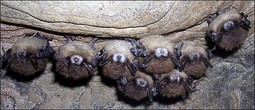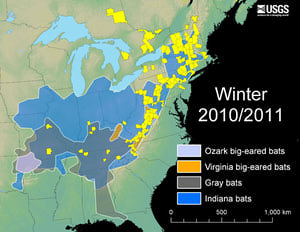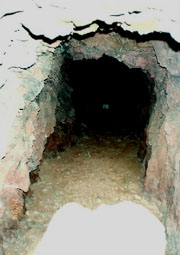White nose syndrome in bats: Difference between revisions
(→Niche) |
|||
| Line 95: | Line 95: | ||
[http://www.sciencedirect.com.proxy2.library.illinois.edu/science/article/pii/S0169534711001923 Puechmaille, S. J., Frick, W. F., Kunz, T. H., Racey, P. A., Voigt, C. C., Wibbelt, G., Teeling, E. C., 2011. “White-nose syndrome: is this emerging disease a threat to European bats?.” Trends In Ecology & Evolution, 26(11), 570-576. ] | [http://www.sciencedirect.com.proxy2.library.illinois.edu/science/article/pii/S0169534711001923 Puechmaille, S. J., Frick, W. F., Kunz, T. H., Racey, P. A., Voigt, C. C., Wibbelt, G., Teeling, E. C., 2011. “White-nose syndrome: is this emerging disease a threat to European bats?.” Trends In Ecology & Evolution, 26(11), 570-576. ] | ||
[Journey Into Amazing Caves - A educational film series that provides basic information about caves <http://www.amazingcaves.com/set_learn_ecology.html>] | |||
[Sample reference] [http://ijs.sgmjournals.org/cgi/reprint/50/2/489 Takai, K., Sugai, A., Itoh, T., and Horikoshi, K. "''Palaeococcus ferrophilus'' gen. nov., sp. nov., a barophilic, hyperthermophilic archaeon from a deep-sea hydrothermal vent chimney". ''International Journal of Systematic and Evolutionary Microbiology''. 2000. Volume 50. p. 489-500.] | [Sample reference] [http://ijs.sgmjournals.org/cgi/reprint/50/2/489 Takai, K., Sugai, A., Itoh, T., and Horikoshi, K. "''Palaeococcus ferrophilus'' gen. nov., sp. nov., a barophilic, hyperthermophilic archaeon from a deep-sea hydrothermal vent chimney". ''International Journal of Systematic and Evolutionary Microbiology''. 2000. Volume 50. p. 489-500.] | ||
Revision as of 05:35, 27 March 2012
Introduction
Other examples:
Bold
Italic
Subscript: H2O
Superscript: Fe3+
This template gives you a general idea of the layout of your page. You are not completely restricted to this format, so feel free to try out different things. I'll give you feedback as you work on your pages. Make sure to copy the "code" of this page to your own page before editing. -Prof Kent
In the introduction, give a brief overview of the microbial interaction that is the topic of this page. Introduce the interaction, the organisms involved, the ecological significance of this interaction, and the importance of microorganisms and their processes in this environment (described in more detail below). What processes do they carry out? What functions do they perform? Why are microbes important in this interaction?
Biological interaction
Provide details of the symbiosis or biological interaction. Is this a specific or general interaction? How do these interactions influence the host or other microbial populations, and their activities? How do these interactions influence other organisms (positive or negative influences)? What is the outcome of this interaction? Are there ecological consequences?
Describe biological interactions using as many sections/subsections as you require. Look at other topics available in MicrobeWiki. Create links where relevant.
Subsection 1
Subsection 1a
Subsection 1b
Subsection 2
Niche
Bats inhabit places where little human interaction occurs. Organisms living deep in caves or abandoned mines have acquired adaptations such as lack of pigmentation, increased sensory structures, reduced eyes or blindness, low reproductive rates, and elongated appendages and antennae. Organisms living in caves must be accustomed to continuous darkness, constant temperatures, and high humidity.
Describe the chemical, or spatial characteristics of the niche where we might find this interaction, using as many sections/subsections as you require. Look at other topics available in MicrobeWiki. Create links where relevant.
Caves
[1] Bats cling to ceilings and walls of the cave. Most caves have water, fish, crayfish, crickets, other insects, bats and any organism that enjoys steady temperatures ranging from 39 – 59 degrees Fahrenheit.
Abandoned Mines
Old mines have an entrance/exit point where the bats can fly out. Inside the old mine, the temperature stays pretty constant like a cave unlike the fluctuating temperatures outside. Also, abandoned mines are dark and stay cool throughout the year, which is a key requirement for nocturnal creatures like bats.
Microbial processes
What microbial processes are important for this microbial interaction? Does this microbial interaction have some ecosystem-level effects? Does this interaction affect the environment in any way? Describe critical microbial processes or activities that are important in this interaction, adding sections/subsections as needed. Look at other topics in MicrobeWiki. Are some of these processes already described? Create links where relevant.
Subsection 1
Subsection 1a
Subsection 1b
Subsection 2
Key Microorganisms
What specific kinds of microbes are typically involved in this interaction? Or associated with important processes? Are some of the groups of microbes from your environment already described? Create links to other MicrobeWiki pages where possible.
North American Bats
Little Brown Bats (Myotis lucifugus Le Conte)
One of the most common bats in North America. Little brown bats are found in almost all of North America. Little brown bats are insectivores. This organism is also nocturnal and it leaves its roost after dusk and before dawn. Now that Geomyces destructans is prevalent in many Northeastern caves, this species population numbers is dwindling.
Northern Long-Eared Bats (Myotis septentrionalis Trovessart)
This species is fairly small in size but has relatively long ears. This species is dispersed along the eastern coast of the United States. Northern long-eared bats are also nocturnal and insectivorous.
Big Brown Bats (Eptesicus fuscus Beauvois)
This species is the largest amongst these four species. The big brown bat is nocturnal and hunts insects at dusk and dawn. Big brown bats are common across the United States.
Tri-colored Bats (Perimyotis subflavus Menu)
Tri-colored bats are commonly found throughout the eastern parts of the United States. This bat, along with the other three species, has a conservation status of “least concern.” Tri-colored bats are also nocturnal and insectivorous.
Geomyces destructans
Geomyces destructans the fungi from the class Leotiomycetes and in the phylum Ascomycota. This fungus forms conidia and conidiospores on the faces, ears, and wings of the bats. Geomyces destructans cannot function at temperatures higher than 24 degrees C (75 degrees F) but thrive in temperatures ranging from 4 – 15 degrees C (39 – 59 degrees F). Geomyces destructans has a similar temperature range as that of winter hibernacula of North American bats.
Current Research
Experimental infection of bats with Geomyces destructans causes WNS
This article suggests there is evidence lacking that Geomyces destructans is the primary source of white-nose syndrome. Also, Lorch et al state that many assume that all fungal infections are commonly connected with immune system dysfunction. Finally, Geomyces destructans is commonly found on European bats’ skin but there are no large bat mortality occurrences that have led scientists to believe that Geomyces destructans is not the sole cause of white-nose syndrome.
White-nose syndrome threatens the survival of hibernating bats in North America
The USGS has compiled information concerning five species of bats: little brown bats, northern long-eared bats, Indiana bats, big brown bats, and tricolored bats. White-nose syndrome had suddenly and rapidly become widespread. Geomyces destructans has played a major role in the swift decrease in bat populations on the northeastern coast.
White-nose syndrome: is this emerging disease a threat to European bats?
Geomyces destructans was found to affect North American bat populations starting in 2006. It was not until 2009 that Geomyces destructans was found to pose a threat in Europe. This article explains the planning of multiple countries trying to gain more information about white-nose syndrome and whether or not it will lead European bats to a similar outcome of North American bats.
References
[Journey Into Amazing Caves - A educational film series that provides basic information about caves <http://www.amazingcaves.com/set_learn_ecology.html>]
Edited by Rachel Luttrell, a student of Angela Kent at the University of Illinois at Urbana-Champaign.



